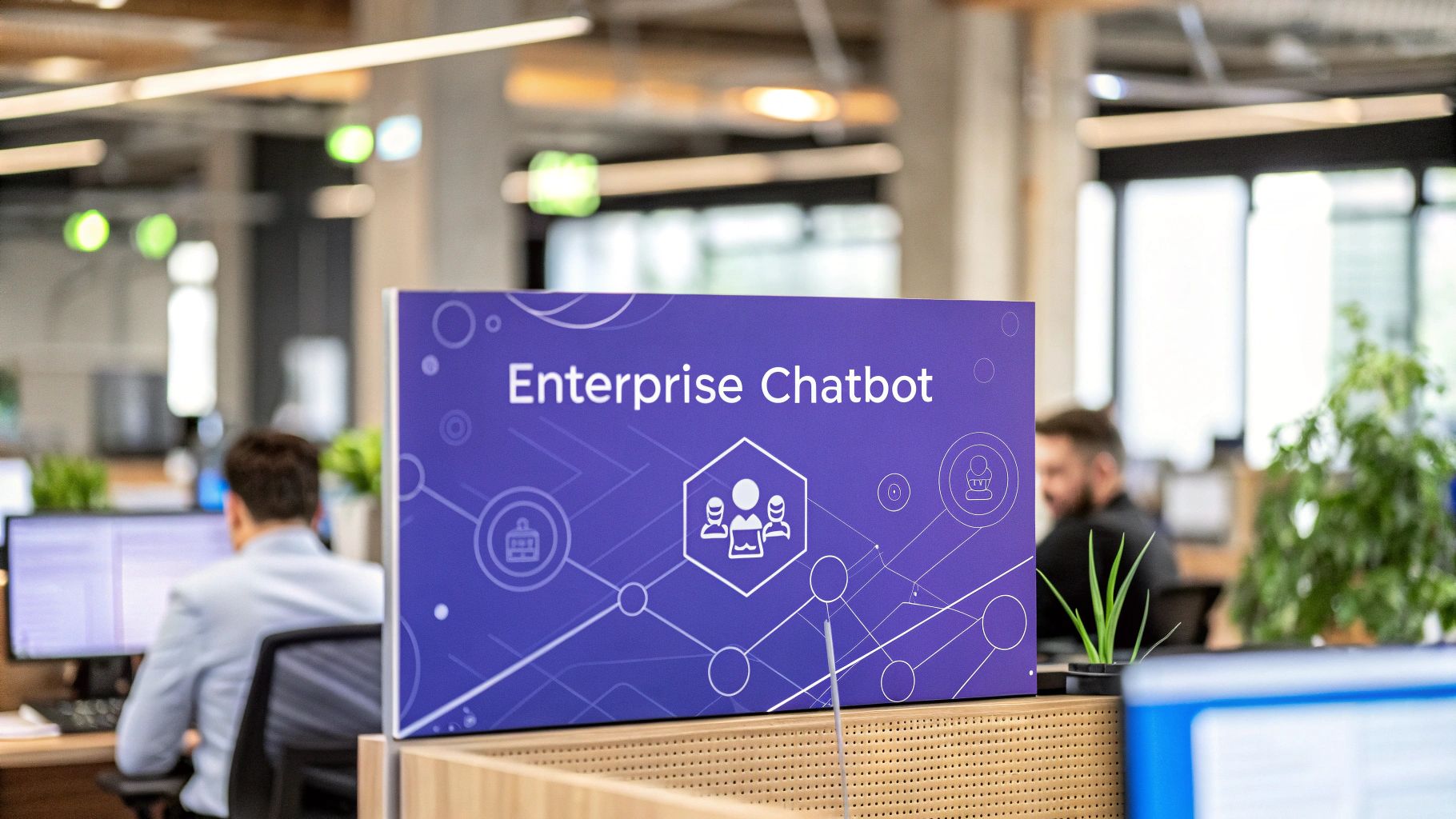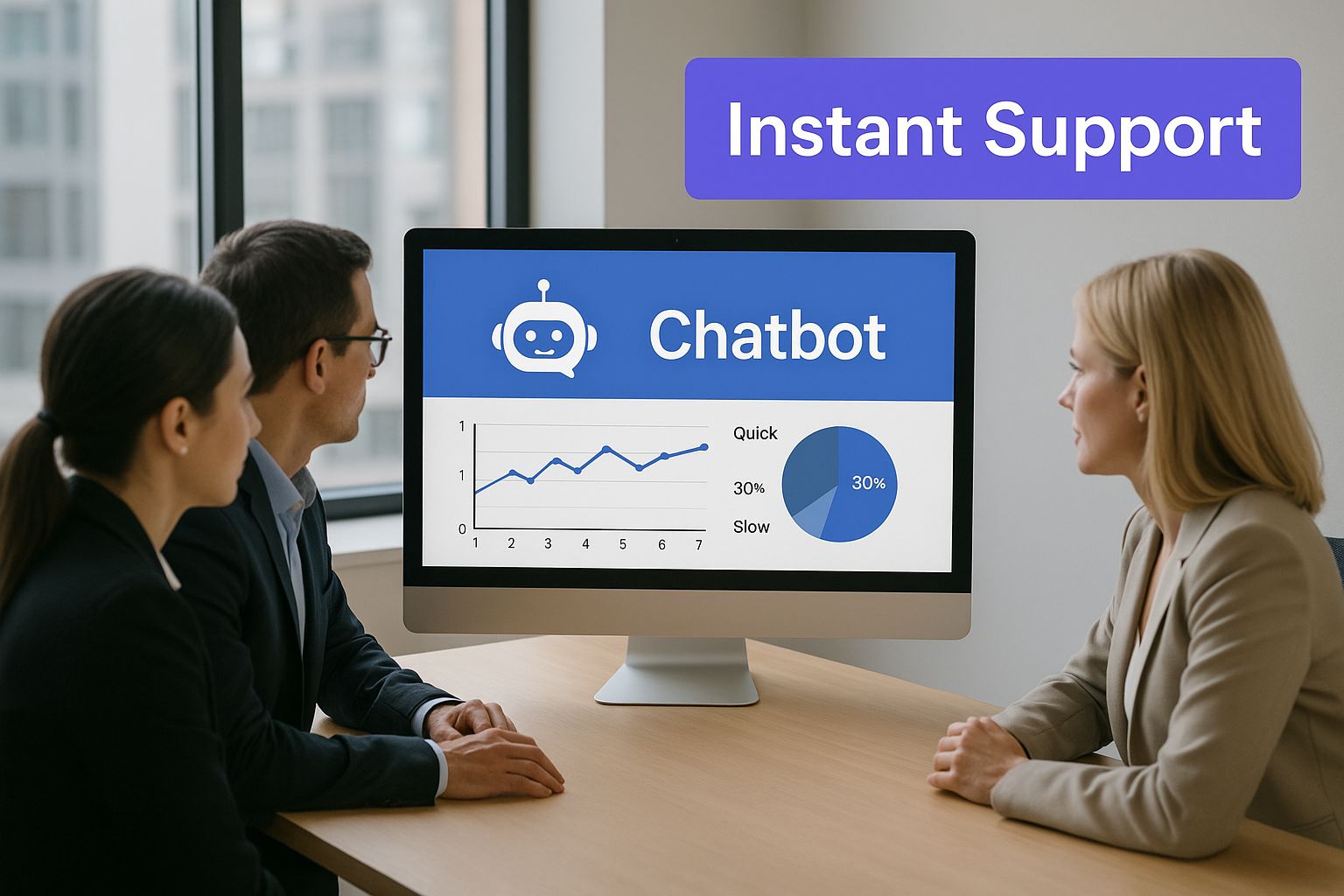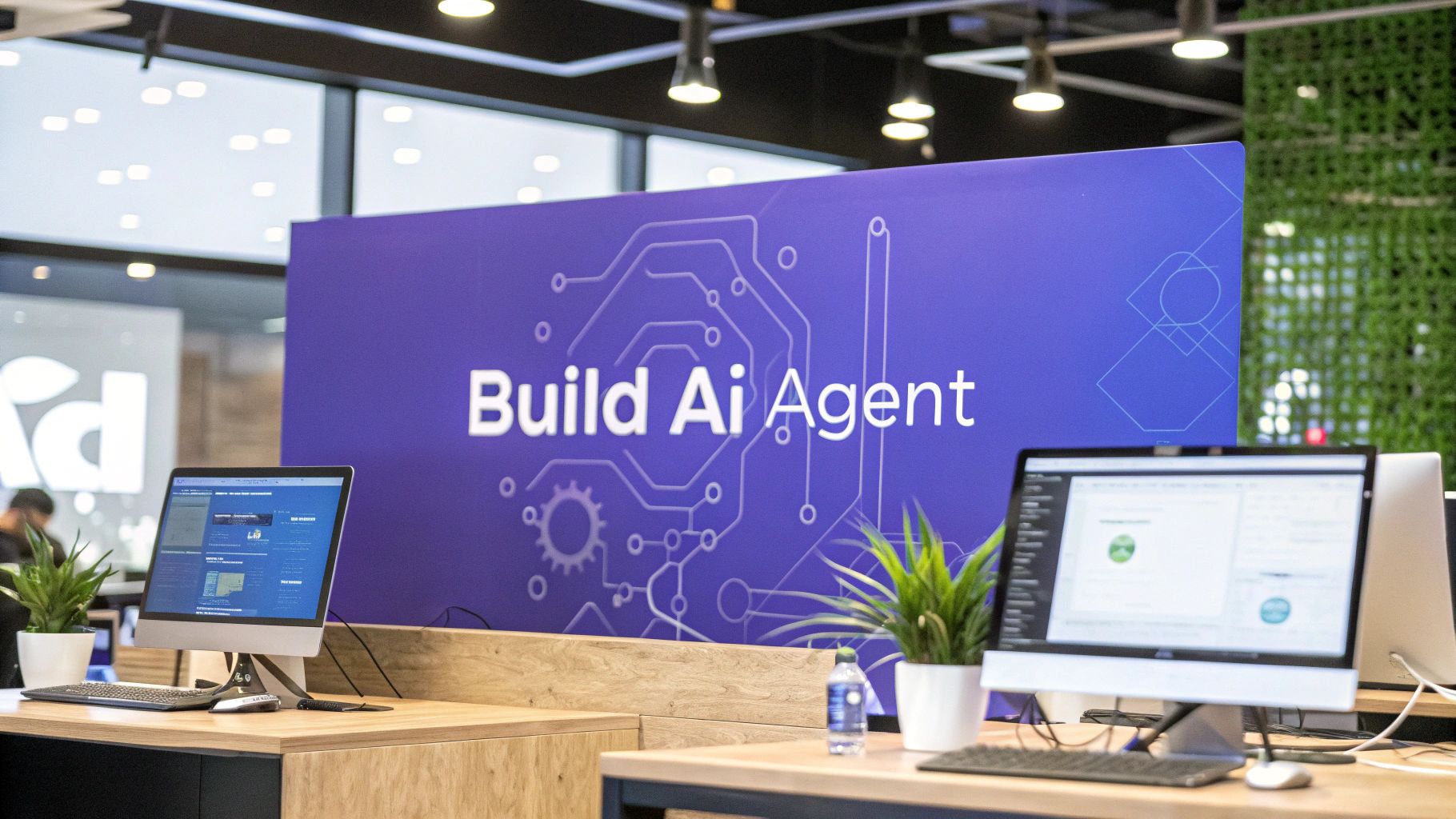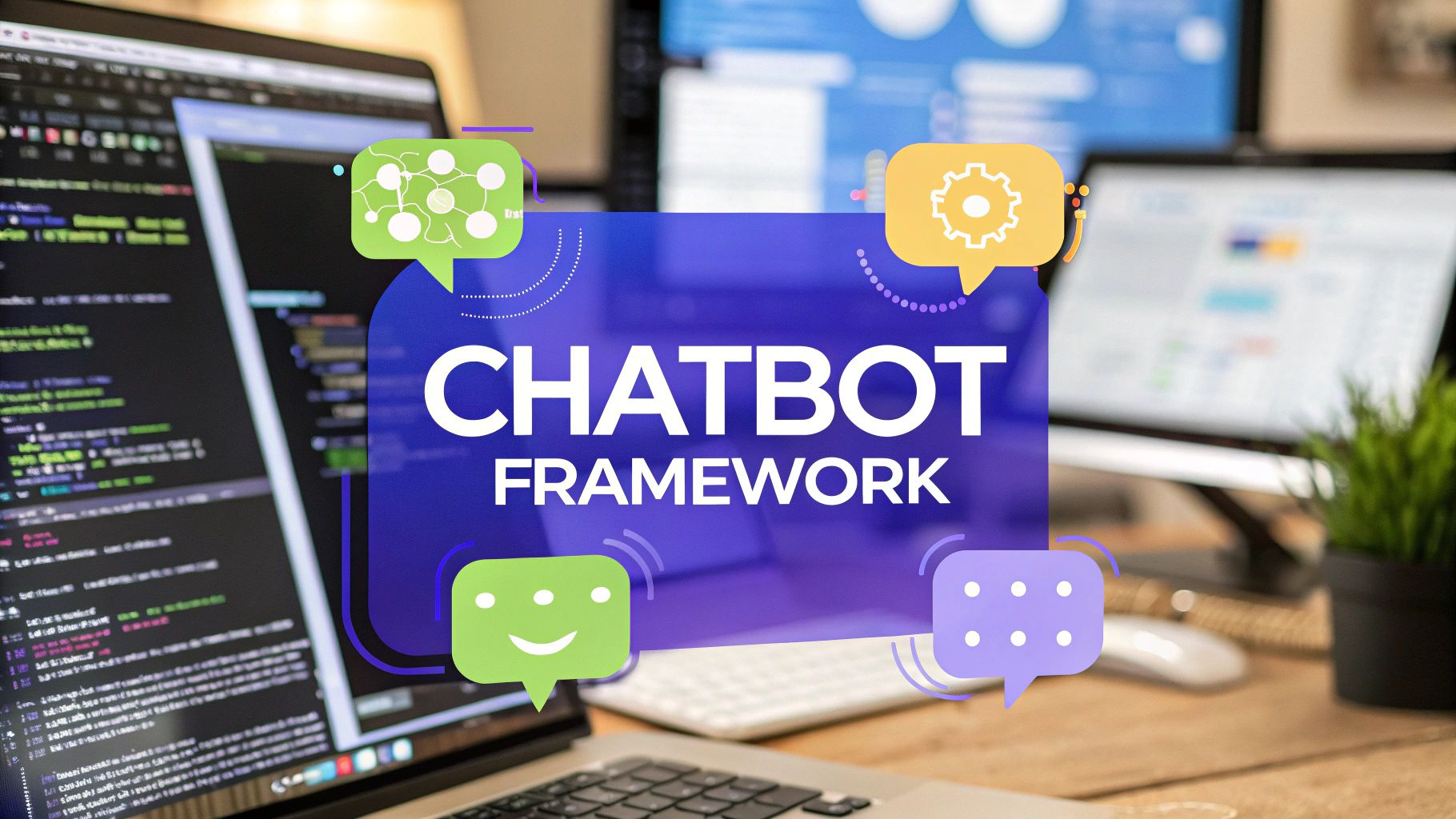Why Your Business Needs a Chatbot for Enterprise
Discover how a chatbot for enterprise can drive efficiency, boost revenue, and redefine customer engagement. Learn to implement AI for real business growth.

When people hear "chatbot," they often think of those simple pop-ups on websites that can answer one or two questions before getting stuck. But an enterprise chatbot is a different beast entirely. It’s not just a digital FAQ; it’s an advanced AI system built to handle complex conversations, plug directly into your core business software, and work at a massive scale.
Think of a standard bot as a helpful receptionist. An enterprise bot is more like an entire automated department.
The Shift to Enterprise Chatbots Is Here
The move toward these sophisticated AI assistants isn’t some far-off trend—it’s happening right now. Businesses are quickly discovering that basic, rule-based chatbots just can't keep up with the complexity, security, and scale that large operations demand. Today's environment requires a level of efficiency and intelligence that only a true enterprise solution can deliver.
This isn't just about answering simple questions anymore. Companies need a chatbot for enterprise that genuinely understands context, manages detailed back-and-forth conversations, and connects to critical systems like CRMs and ERPs. This creates a seamless experience everywhere, from the public-facing website to internal platforms like Google Chat.
This infographic shows how enterprise chatbots are designed to slot directly into the corporate workflow, delivering instant support where employees already are.

As the image shows, these tools become an accessible, on-demand resource for the whole team, making work flow more smoothly.
Differentiating Enterprise from Standard Bots
It’s important to understand that not all chatbots are created equal. The difference between a standard bot and an enterprise-grade solution is night and day. A standard bot usually follows a simple script or decision tree, but an enterprise bot uses advanced AI and Natural Language Processing (NLP) to interpret and act on nuanced user requests.
This distinction is crucial. A small business might get by just fine with a simple bot on its contact page. But a large organization needs a system that guarantees top-notch security, can handle huge volumes of traffic, and integrates deeply with its existing tech stack.
The market's explosive growth tells the same story. What was a $396.2 million market in 2019 is expected to skyrocket to between $10 billion and $15 billion by 2025. You can explore the full analysis of these chatbot statistics to see just how fast things are moving.
To make the differences crystal clear, let's break them down side-by-side.
Enterprise Chatbot vs Standard Chatbot at a Glance
This table highlights the fundamental differences between chatbots designed for large-scale enterprises and the standard bots often used by smaller businesses.
Ultimately, choosing a chatbot for enterprise isn't just about adding another tool. It's an investment in a powerful, centralized platform that can grow and adapt right alongside your organization.
Driving Real Business Value Across Your Organization

An enterprise chatbot does more than just answer questions. It delivers tangible, measurable value by changing how individual departments get work done. Think of it less like a generic tool and more like a dedicated, hyper-efficient team member for every part of your business—one that works around the clock to drive growth and cut down on busywork.
This value isn't just theoretical. The real power of an enterprise chatbot shows up when you see its direct impact on revenue, costs, and employee productivity. It’s an investment that pays for itself by automating low-value tasks and freeing up your teams to focus on the strategic work that actually matters.
Let’s break down how this works in a few key areas.
Supercharging Your Sales Engine
For any sales team, time is money. An enterprise chatbot acts as a tireless lead qualification specialist, engaging with website visitors 24/7. It can ask qualifying questions, share personalized product info, and even book demos directly onto your sales reps' calendars.
This means your reps can start their day with a schedule full of high-intent prospects instead of a long list of cold leads to sort through. That kind of automation has a direct line to a healthier sales pipeline and, ultimately, more revenue.
- 24/7 Lead Capture: Never miss an opportunity just because it's after hours. The bot is always on, ready to capture and qualify leads.
- Instant Engagement: Get immediate answers to prospect questions, keeping them on your site and away from competitors.
- Automated Scheduling: Eliminate the frustrating back-and-forth of booking meetings, freeing up reps to do what they do best: sell.
Optimizing Business Operations
Internal operations—from IT support to HR inquiries—are often swamped with repetitive, high-volume requests. An enterprise chatbot acts as an automated expert, instantly resolving thousands of these common issues without needing a human.
Think of it as a central knowledge hub that deflects tickets from your helpdesk.
An employee who needs a password reset or wants to clarify a company policy gets an immediate answer from the bot. Meanwhile, your operations team is free to tackle complex, system-wide challenges. This is where you start to see significant cost savings.
The numbers back this up. Some companies report annual savings of up to $300,000 by using bots to handle routine internal questions. Globally, this tech is estimated to cut down 2.5 billion labor hours each year, showing just how much it can impact workforce efficiency.
This kind of automation isn't just for internal teams. You can explore how an AI chatbot for customer service can further reduce your operational load while keeping users happy.
A Force Multiplier for Developers
Development teams run on focus and uninterrupted work. A well-integrated enterprise chatbot can become a huge productivity booster, automating routine updates and giving them instant access to technical information.
For example, you can set up a bot to send automated notifications about build statuses, deployment failures, or critical system alerts directly into a team's Google Chat or Slack channel. Everyone stays in the loop without the constant context switching.
It can also act as an intelligent search tool for your technical documentation. Instead of digging through a massive knowledge base, a developer can simply ask the bot a question in plain English and get back a precise answer, maybe even with a code snippet. This drastically cuts down on research time and helps your most technical minds stay focused on building great things.
The Technology That Powers Enterprise AI

So, what really separates a basic, run-of-the-mill chatbot from an enterprise AI powerhouse? The difference isn't just a few fancy features—it’s everything humming away under the hood. These core technologies are what allow a bot to act less like a script and more like a strategic part of your team.
Think of it like the difference between a go-kart and a high-performance vehicle. They both have wheels, but only one is built to handle the demands of a real racetrack. Let's pop the hood and look at the non-negotiable tech that gives an enterprise chatbot its muscle.
Natural Language Processing: The Brain of the Operation
The most fundamental piece of the puzzle is Natural Language Processing (NLP). This is the bot’s “brain,” giving it the ability to understand what people mean, not just the specific keywords they type. A simple bot gets stuck if you don't use the exact phrase it’s programmed to recognize.
An enterprise bot with strong NLP, on the other hand, can handle context, slang, and even typos. It gets that "Where's my stuff?" and "Can you give me a shipping update on order #12345?" are asking for the same thing. This is what makes the conversation feel genuinely helpful instead of like you're talking to a wall.
Omnichannel Support: Being Everywhere at Once
In any big company, conversations are happening all over the place—on the website, inside a mobile app, or across internal tools like Google Chat or Slack. Omnichannel support means the chatbot can carry on a single, seamless conversation across all of them.
Imagine a customer starts a chat on your website, continues it on their phone during their commute, and gets a final confirmation by email. The chatbot remembers the entire conversation history, creating a unified experience that just works.
This isn't just about showing up on multiple channels. It’s about creating one persistent, intelligent dialogue that follows the user wherever they go, making support feel effortless and consistent.
Robust Security: The Digital Fortress
For any serious business, data security is everything. A true chatbot for enterprise is built like a digital fortress, armed with protocols to protect sensitive customer and company information. This is way more than just basic password protection.
It’s a multi-layered security strategy that includes:
- End-to-End Encryption: Securing data while it's moving and while it's stored, so conversations stay private.
- Compliance Certifications: Meeting strict industry standards like GDPR for data privacy, HIPAA for healthcare, and SOC 2 for operational security.
- Role-Based Access Controls: Making sure only authorized people can access specific bot functions and data.
These security measures aren't optional extras; they're deal-breakers. They build trust with customers and internal teams alike, proving the chatbot is a secure partner in your operations.
True Scalability and Advanced Analytics
Scalability is another huge differentiator. An enterprise chatbot has to be able to jump from handling a few dozen conversations to millions at once without breaking a sweat. That’s the power of true scalability—the ability to grow with you on demand.
But it’s not just about handling volume. These systems offer advanced analytics that deliver deep insights. They don’t just count chats; they analyze conversation trends, pinpoint common customer frustrations, and measure how often issues get resolved. This data transforms your chatbot from a simple support tool into a genuine source of business intelligence.
Market data backs this up, showing that generative AI chatbots hold a dominant market share of around 76.4%. It’s clear that businesses are relying on these advanced language models. Standalone chatbots make up the biggest slice of this usage, valued for their flexibility and deep integration options. You can discover more insights about top generative AI chatbots to see how they're shaping the market.
Integrating Your Chatbot with Your Tech Stack
A chatbot that works in a silo is a serious missed opportunity. Its real power only gets unlocked when it’s connected to the business systems you already use every day.
Think of it like this: your enterprise chatbot has a brain (the AI), but without connecting to your business’s “limbs”—your other software—it can’t actually do anything meaningful. Seamless integration is what turns a simple Q&A bot into an automated, action-oriented member of your team.
This is how a chatbot for enterprise becomes the intelligent hub that talks to your entire tech stack, from customer-facing platforms to internal tools. It’s no longer just answering questions; it's doing things. It can pull real-time data, update records, and trigger workflows across different departments, creating a truly unified way of working.
Connecting to Your Core Business Platforms
The goal here is to give your chatbot context and capabilities. When your bot can tap into data from your core systems, its responses become more personal, accurate, and genuinely helpful. The most powerful connections are almost always with your Customer Relationship Management (CRM) and Enterprise Resource Planning (ERP) systems.
For example, connecting your chatbot to a CRM like Salesforce completely changes your sales process. When a prospect interacts with the bot on your website, it can:
- Instantly check the CRM to see if the person is a new lead or an existing customer.
- Add details from the conversation to the lead’s profile, like their specific interests or pain points.
- Automatically update the lead status or assign them to the right sales rep.
Likewise, an integration with an ERP system like SAP gives the chatbot access to critical operational data. A customer can ask, "Where is my order?" and the bot can pull a real-time status update by querying the ERP directly. This lifts a huge weight off your support team.
Strategic Integration Tip: Don't try to connect everything at once. Start with a phased integration roadmap. Pick the one system that will deliver the most immediate value—like your CRM for lead generation or your helpdesk software for ticket deflection. Nail that connection before you move on to the next.
This approach helps you score quick wins and build momentum. To make these deep connections possible, you'll need robust APIs. Understanding how to use an API for chatbot integration is the key technical step to making your chatbot a true extension of your business software.
Automating Workflows with Internal Tools
Integration isn’t just about customer-facing tasks. Connecting your chatbot to internal communication platforms like Google Chat or Slack can dramatically boost employee productivity. The bot becomes an on-demand assistant that lives right where your teams already work.
A developer could ask the bot about a recent code deployment, or an HR manager could use it to push out company-wide announcements. This stops people from having to constantly switch between different apps for routine tasks. The screenshot below shows how tools like Zapier can create powerful automated workflows between chatbots and Google Chat without needing to write a single line of code.
This image highlights a simple but powerful idea: connect your chatbot to your internal chat app, and you can trigger automated messages based on actions in other systems, keeping your team in the loop in real-time.
Avoiding Common Integration Hurdles
While the benefits are clear, integration projects can hit a few snags. One of the biggest hurdles is keeping your data clean. When information is flowing between multiple systems, you need clear rules to prevent data from getting corrupted or duplicated.
Another common problem is a lack of planning for scale. The first integration might work perfectly with a small group of users, but will it hold up when thousands of people are interacting with the bot at the same time? Building with scale in mind from day one is essential.
Ultimately, a successful chatbot for enterprise project hinges on a well-planned strategy that accounts for data security, scalability, and a clear roadmap for what comes next.
Enterprise Chatbots in Action
Theory and technical specs are one thing, but seeing a chatbot actually solve a real business problem is something else entirely. It’s time to move from concepts to reality and look at how these AI systems are creating measurable value for companies right now.
The true impact of an enterprise chatbot is best understood through its application. These aren’t just hypotheticals; they’re real stories of transformation happening in logistics, finance, and B2B software sales.
Streamlining Global Logistics and Support
Picture a massive international logistics company juggling millions of parcels every single day. During peak season, their call centers were completely swamped with one simple, repetitive question: "Where is my package?" This constant flood of calls created long hold times, frustrated customers, and burned-out support agents.
Their solution was to roll out an enterprise chatbot tied directly into their global tracking system.
- The Problem: Overwhelming call volume for basic tracking requests, which drove up operational costs and tanked the customer experience.
- The Chatbot Solution: An AI-powered bot that could understand natural language queries about package locations. It had real-time access to shipment data and could give customers instant, accurate updates around the clock.
- The Outcome: The chatbot successfully handled millions of tracking inquiries, slashing call center volume by 40% during their busiest times. This move didn’t just cut costs; it also freed up human agents to tackle the complex shipping issues that truly needed their expertise.
Accelerating Internal Compliance and Knowledge Access
Now, let's step inside a large financial services firm. Their employees—from analysts to advisors—had to navigate a maze of complex and ever-changing compliance regulations. Finding one specific rule often meant spending hours digging through dense internal documents or waiting for an answer from a small, overworked legal team.
To fix this, the firm built an internal chatbot to serve as an on-demand compliance expert.
Instead of wading through manuals, employees can now just ask the bot direct questions like, "What are the disclosure requirements for a client in California?" The bot, trained on the company's entire library of compliance documents, pulls up an instant, accurate answer with a link to the source document.
This is a perfect example of a chatbot serving a critical internal function. The result was a huge leap in employee efficiency. Research time for tricky compliance questions was cut from hours down to just seconds. This not only boosted productivity but also lowered the risk of non-compliance from human error or old information.
Boosting B2B Sales and Lead Qualification
Finally, let's look at a B2B software company with a high-value product. Their website was getting plenty of traffic, but the sales team was struggling to separate the hot leads from the noise. Reps were wasting valuable time talking to prospects who weren't a good fit, while some high-potential leads were leaving the site without ever speaking to anyone.
They implemented a sophisticated enterprise chatbot on their website to act as a first-line sales development rep. The bot’s job was to engage visitors, ask a few smart qualifying questions, and pinpoint high-intent prospects. If a lead matched specific criteria (like company size and job title), the bot would immediately offer to book a demo on the right sales rep’s calendar. If you're looking to do something similar, learning how to add a chatbot to your website is a great place to start.
The results were impressive. By automating the top of their sales funnel, the company saw a 25% increase in qualified demo bookings. Their sales team could finally focus their energy on conversations with serious, well-vetted buyers, which led to a shorter sales cycle and a major bump in revenue.
Of course. Here is the rewritten section, following the provided style guide and examples.
Common Questions About Enterprise Chatbots
So, you're thinking about bringing an enterprise chatbot into your business. Smart move. But it's natural to have questions. Decision-makers always want to know about the investment, what implementation actually looks like, and—most importantly—how secure the whole thing is.
Let's cut through the jargon and get straight to the practical answers you're looking for.
How Do We Measure the ROI of an Enterprise Chatbot?
Thinking about the return on a chatbot isn't just about saving money; it's also about making money. You've got to look at it from both sides to see the full picture.
On the cost-savings side, the math is pretty direct. You can literally count the number of support tickets or calls your human team didn't have to handle. You'll also see ticket resolution times drop and a clear dip in the operational costs for your support teams. This is the stuff that shows up on a spreadsheet almost immediately.
But don't stop there. For revenue, the focus shifts to growth. Keep an eye on the number of chatbot-qualified leads that get handed off to sales and, more importantly, how many of them convert. You can even track the customer lifetime value for users who interact with the bot, proving its role in keeping customers happy and loyal.
To get the full picture, you need to mix these hard numbers with softer feedback. Use metrics like Customer Satisfaction (CSAT) and Net Promoter Score (NPS) from your bot conversations. When you combine real financial impact with proven customer happiness, you've got a business case that’s impossible to ignore.
This approach proves that a chatbot isn't just a cost center. It’s a growth engine.
What Is a Realistic Implementation Timeline?
There's no one-size-fits-all answer here. The timeline for getting an enterprise chatbot up and running really depends on how ambitious you are and how many systems you need it to talk to.
A simple pilot project can be surprisingly quick. If you’re building a bot for a single, focused task—like capturing leads on your website or answering the top 10 HR questions—you can often get it live in just 4-8 weeks. It’s a fantastic way to get a quick win.
A full-scale enterprise solution, however, is a different beast. If you want a bot that's deeply integrated with your core systems (like your CRM and ERP), powered by advanced AI, and available on multiple channels, you should plan for 3-6 months. That timeline usually includes:
- Discovery and Planning: Getting crystal clear on goals, user journeys, and technical needs.
- Development and Integration: Building the conversational logic and connecting the bot to your essential platforms.
- Rigorous Testing: Running thousands of simulated conversations to iron out any kinks before launch.
- Phased Rollout: Releasing the bot to a small user group first, gathering feedback, and then opening it up to everyone else.
Starting with a minimum viable product (MVP) is almost always the right move. You deliver value fast, collect real-world data, and build momentum for a bigger, more strategic rollout.
How Do Enterprise Chatbots Handle Security and Compliance?
For any serious business, security isn't just a feature; it's the foundation. Enterprise chatbots are built from the ground up to operate in tightly regulated spaces and keep your most sensitive data locked down. It’s completely non-negotiable.
Top-tier platforms use a multi-layered security model, essentially building a digital fortress around your conversations. This starts with end-to-end encryption, making sure data is secure whether it's sitting still or on the move. Connections to other systems are made through secure APIs, and strict role-based access controls mean only authorized people can manage the bot or see its data.
Beyond the basics, compliance is everything. The best chatbot providers are certified for the big industry standards:
- GDPR: Protecting the data of citizens in the European Union.
- HIPAA: Safeguarding health information in the healthcare world.
- SOC 2: Guaranteeing best practices for operational security and data management.
Features like automated data masking to hide personally identifiable information (PII) and detailed audit logs of every conversation are standard. These aren't just nice-to-haves; they ensure your organization can prove it’s meeting its regulatory duties. Just look at the defense technology company Anduril—they built their internal chatbot on a secure cloud foundation specifically to handle highly sensitive CUI data. That tells you everything you need to know about how critical this is.
Can One Chatbot Support a Global Multilingual Audience?
Yes, absolutely. This is one of the most powerful features of a modern enterprise chatbot. Thanks to advanced multilingual Natural Language Processing (NLP) models, a single chatbot can intelligently serve a global audience of both customers and employees.
This completely changes the game for global companies. Instead of building, managing, and paying for separate bots in every language, you can deploy one smart system. The bot automatically detects a user's language from their first message and responds fluently in that same language, without missing a beat.
It means you can deliver a consistent, high-quality experience across the world without your costs and complexity spiraling out of control. For any company looking to scale its support and engagement globally, this isn't just a benefit—it's essential.
Ready to see what a powerful AI assistant can do for your business? With Chatiant, you can easily create a custom chatbot trained on your own data. Integrate it with your website, Google Chat, and more to automate workflows and supercharge your sales, operations, and support teams. Build your custom AI agent with Chatiant today!


